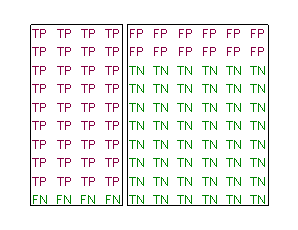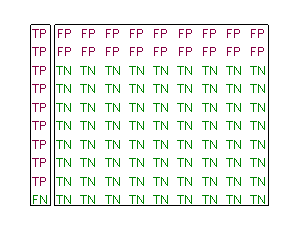StATS: What is a diagnostic test?
A diagnostic test is a procedure which gives a rapid, convenient and/or
inexpensive indication of whether a patient has a certain disease. Some
examples of diagnostic tests are:
The Yale-Brown obsessive-compulsive scale, a simple yes/no answer to
the following question: Do you often feel sad or depressed? In a study
of stroke patients at the Royal Liverpool and Broadgreen University Hospitals
(BMJ 2001; 323: 1159),
this test was shown to perform well compared to a more complex measure, the
Montgomery Asberg depression rating scale.
The SCOFF questionnaire asks five yes/no questions to determine
whether a patient has an eating disorder.
- Do you ever make yourself sick because you feel uncomfortably full?
- Do you worry you have lost control over how much you eat?
- Have you recently lost more than one stone in a 3 month period?
- Do you believe yourself to be fat when others say you are thin?
- Would you say that food dominates your life?
Two or more yes answers is considered a positive test. In a study of 341
consecutive patients at two general practices in southwest London (BMJ
2002; 325: 755-756), these patients were given the SCOFF questionnaire
and then a formal interview based on Diagnostic and Statistical Manual of
Mental Disorders, (fourth edition). The interview lasted 10-15 minutes and
the interviewer did not know that score on the SCOFF questionnaire. The SCOFF
questionnaire produced results that were comparable to the formal interview.
Patients with rectal bleeding will sometimes develop colorectal
cancer. In a study at a network of practices in Belgium (BMJ
2000; 321; 998-999), 386 patients presented with rectal bleeding between
1993 and 1994. After following these patients for 18 to 30 months, only a few
developed colorectal cancer.
A standard electrocardiogram can produce a measure called QTc dispersion.
In a study of 49 patients with peripheral vascular disease (BMJ
1996; 312: 874-878), all were assessed for their QTc dispersion values.
These patients were then followed for 52 to 77 months. During this time,
there were 12 cardiac deaths, 3 non-cardiac deaths, and 34 survivors. A value
of QTc dispersion of 60 ms or more did quite well in predicting cardiac
death.
Assessing the quality of a diagnostic test
To assess the quality of a diagnostic test, you need to compare it to a
gold standard. This is a measurement that is slower, less convenient, or more
expensive than the diagnostic test, but which also gives a definitive
indication of disease status. The gold standard might involve invasive
procedures like a biopsy or could mean waiting for several years until the
disease status becomes obvious.
You classify patients as having the disease or being healthy using the gold
standard. Then you count the number of times that the diagnostic test agrees
and disagrees with the gold standard of disease and the number of times that
the diagnostic test agrees and disagrees with the gold standard of being
healthy.
This leads to four possible categories.
- TP (true positive) = # who test positive
and who have the disease,
- FN (false negative) = # who test negative
and who have the disease,
- FP (false positive) = # who test positive
and who are healthy, and
- TN (true negative) = # who test negative
and who are healthy.
A good diagnostic test will minimize the number of false negative and false
positive results.
The role of prevalence
Prevalence is the proportion of patients who have the disease in the
population you are testing. This can vary quite a bit in real situations. For
example, the prevalence of a disease is often much higher in a tertiary care
center than at a primary care physician's office. Prevalence can also vary
sometimes by seasons of the year. It can also vary sometimes by race or
gender.
Prevalence plays a large role in determining how effective a diagnostic
test is. Let's look at a hypothetical situation. In the graph below, patients
on the left have the disease and patients on the right are healthy. If you
have the disease, the test can either be a true positive test (TP) or a false
negative (FN). If you are healthy, the test can either be a false positive
(FP) or a true negative (TN).

This situation represents a disease with high prevalence. The test performs
reasonably well. Among the patients with disease only a few test negative.
Among the healthy patients only a few test positive. A positive test is
reasonably definitive because the number of true positives is much larger
than the number of false positives.
Let's consider a different hypothetical situation.

In this situation, the prevalence of the disease is much lower. As before
only a few of the patients with disease test negative and only a few of the
healthy patients test positive. But since there are so many more healthy
patients, their false positive results swamp out the true positive results.
In general, when the prevalence of the disease you are testing is rare,
it becomes harder to positively diagnose that disease. It takes a very
very good test to find the needle in the haystack.
This page was written by
Steve Simon while working at Children's Mercy Hospital. Although I do not hold the copyright for this material, I am reproducing it here as a service, as it is no longer available on the Children's Mercy Hospital website. Need more
information? I have a page with general help
resources. You can also browse for pages similar to this one at Category:
Definitions, Category:
Diagnostic testing.

